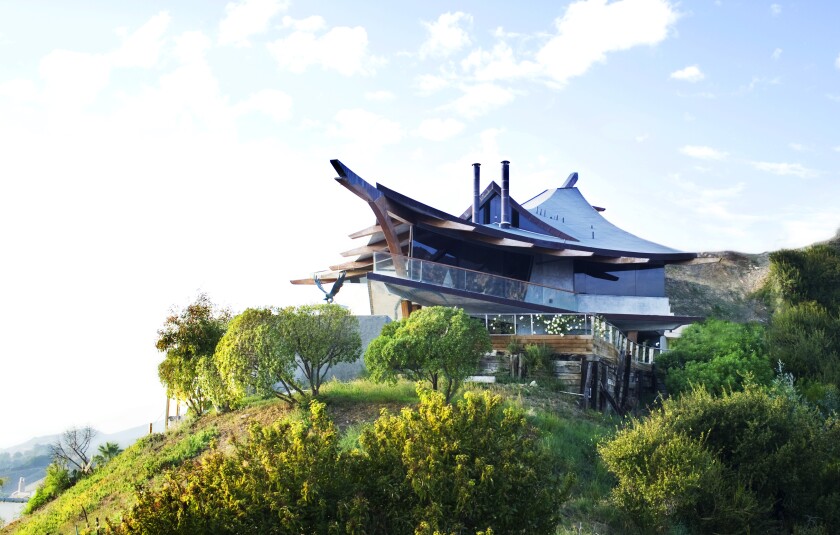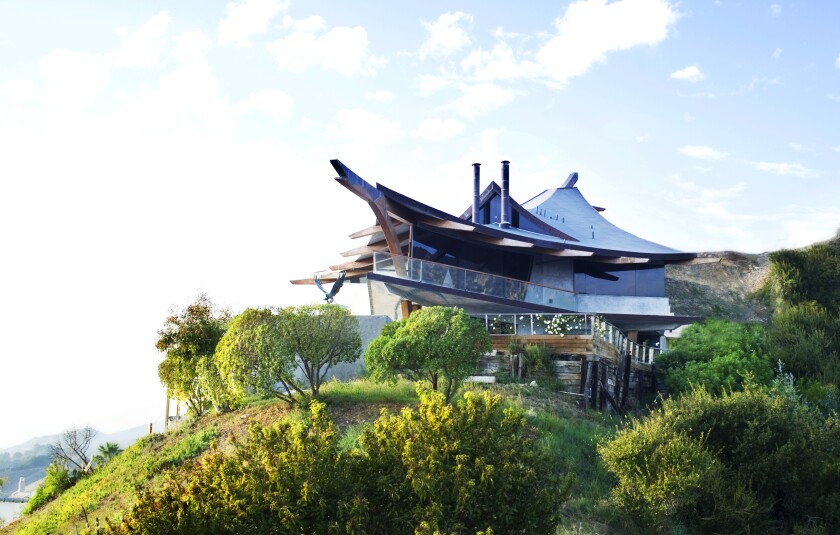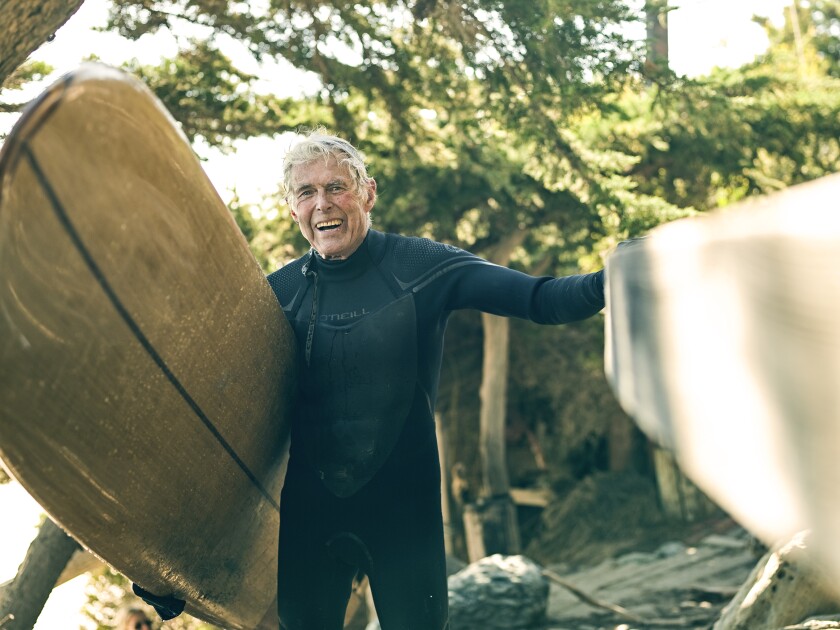
Architect of dramatic Malibu houses Harry Gesner dies at 97
Harry Gesner was an architect who did not have a extravagant degree — nor, for a lot of yrs, even an architectural license. In reality, the sum full of his training consisted of attending lectures by Frank Lloyd Wright, then doing the job as a carpenter. The absence of credential was minimal deterrent to Gesner, who more than the system of his daily life created and crafted dozens of prized properties close to Los Angeles.
These involved the Cole Dwelling, crafted for swimwear magnate Fred Cole in 1954 a fantasy bachelor pad with a Polynesian air that turned a darling of era men’s magazines as properly as the Hollywood Boathouses, concluded in 1959, a collection of residences that cantilever more than a steep hillside at the Cahuenga Go, resembling house barges docked on the aspect of the mountain. (The site was so difficult to make on that Gesner received Norwegian shipbuilders to help him with the task.)
He is perhaps greatest regarded, even so, for the Wave Residence in Malibu, crafted in 1957, which juts out in excess of the sand with a collection of crested roofs that feel to evoke the types of the waves that curl just below. In point, Gesner afterwards instructed Curbed that he created the developing “while sitting on a surfboard out by some rocks close to the shore. I drew it on the board with a grease pencil.”
Gesner, who was known for coming up with some of L.A.’s most idiosyncratic residences, structures that seem to be to draw their form from the swells of the Pacific Ocean and the wooded peaks of the Santa Monica Mountains, died Friday in Malibu. He was 97 several years aged the induce was troubles related to cancer.
His death was confirmed by his stepson Casey Dolan. In addition to Dolan, he is survived by daughter Tara Tanzer-Cartwright and sons Jason Gesner and Zen Gesner.

A see of the Eagle’s Look at residence. At first developed in 1957, it was rebuilt in 1997 right after a wildfire.
(Steven Lippman)
Gesner died in the seaside dwelling he designed for himself and his family: an idiosyncratic composition identified as “the Sandcastle,” which inhabited the same Malibu cove as the Wave House. Accomplished in 1970, the cylindrical house featured a storybook tower that experienced, at its heart, a brick hearth, and a window-lined prevalent area fabricated from reclaimed wood.
The rounded layout, he stated, built economical use of area and nodded to kinds that exist in mother nature. “Go again through background,” he stated. “Nests are round, every thing is round, the Earth, earth photo voltaic units, it’s all round. Why combat it?”
Zen Gesner states the residence was “a dream” to develop up in. “It was the things of fairy tale textbooks. It was key passageways and whimsical stained-glass home windows that brought gentle into each room.”
Even though a Modernist, Gesner was singular in his method to his patterns. In a 2012 monograph of his work, “Houses of the Sundown Sea: The Architectural Vision of Harry Gesner,” Lisa Germany notes that the architect resisted the “fine-boned” Modernism of Southern California mid-century, as embodied by the Scenario Examine Residences, in favor of a much more rugged glance. Gesner, she wrote, embraced “the monumental details of the past — most notably castles and ships.”
His Eagle’s Check out Property in Malibu, finished in 1957, will take the type of a triangle, with a roofline that extends around a hillside with a pointed beam — a sort that resembles the prow of a ship.
“Everything was quite normal. It was incredibly organic,” suggests Lisa Stoddard, who, for far more than a 10 years served as the architect’s assistant and archivist. “It was pretty whimsical as perfectly.”
Gesner designed dozens of households all over Southern California above the course of his job and ongoing to sketch out thoughts until finally the close of his daily life — all from the tower in his dwelling, where he would ascend each day to draw. Three or 4 yrs ago, when he could no longer make the climb, he’d draw at his desk or while lying in bed.
When questioned by the New York Times in 2012 about which one of his homes was his favored, he replied, “It’s normally the dwelling I’m building.”

Architect Harry Gesner in an undated photograph.
(Steven Lippman)
If at any time there ended up an architect with a Southern California pedigree, it was Gesner — a surfer with movie-star fantastic seems and a style for journey.
Harry Harmer Gesner was born in Oxnard on April 25, 1925, the son Harry Gesner, an inventor and engineer, and Ethel Harmer, an artist. On his mother’s facet, his relatives stretches back to some of the earliest land grant people in Santa Barbara, and his maternal grandfather, Alexander Harmer, was a effectively-identified painter of Western scenes. Gesner was also similar to John K. Northrop, inventor of the flying wing plane and founder of the Northrop company.
When it came to layout, the architect as soon as explained to Vanity Fair, “The genes had been all in line for me.”
When Gesner was a young boy, the household relocated to the Santa Monica area, where Gesner grew up — attending Santa Monica Significant Faculty and studying to fly planes by the time he was a teen. Soon after graduation, he served in the army and was part of the the D-Day landing at Omaha Beach — an experience, he later wrote, in which he was “changed from a boy to a gentleman right after about a minute with the wounded, dying and about-to-be-useless.”
For the duration of the Battle of the Bulge, he was knocked unconscious by a piece of particles when a German tank blasted by the stone farmhouse he was hiding in. By the time he was taken to a medical center, he was in close proximity to frozen and in risk of losing his legs. Dolan suggests his stepdad would usually recall lying in his medical center bed, rubbing his legs to hold the blood circulating and thereby continue to keep his limbs. As a result of sheer willpower, he did.
For all of its devastations, the war helped feed his interest in architecture. Gesner generally entertained himself in wartime Europe by sketching castles and even exploring them. “Castles are fingers-on architecture,” he informed the Getty Centre blog in 2016. “The masons made and constructed them, from the intricate understanding they experienced in their heads. You really don’t obtain options for medieval castles.”
Immediately after he was discharged from the navy, Gesner headed off to Ecuador to hunt for pre-Columbian artifacts. As he when explained to Architectural Digest, “I’m the primary Indiana Jones.”
On his way back to Los Angeles, he stopped off in Mexico Town, the place he met actor Errol Flynn and ended up operating as a deckhand on his yacht, the Sirocco.
Gesner used a brief stint in New York Metropolis on the G.I. Bill, getting the coach up to New Haven to go to lectures by Wright at Yale. But he declined to pursue official scientific studies in the field, returning alternatively to Los Angeles, where he labored in carpentry, masonry and whichever other setting up trades he could lay his hands on.
The 1st property he completed was for his mother and father it was crafted out of adobe brick. He crafted other houses with adobe, but above time he became recognised for the ways he labored with wooden — specially reclaimed wood, which he felt injected new life into a structure.
Gesner also formulated a status for his willingness to make on really tough heaps. Told a whole lot was unbuildable, he would pursue the challenge until he identified a way to develop it.
“He was indefatigable,” Dolan claims. “He seldom rested. He generally experienced projects in head.”

Harry Gesner on a surf break. His perform was inspired by the water and California’s mountainous landscape.
(Steven Lippman)
Gesner also had a storied personal daily life — married four times above the study course far more than six many years. This bundled a short marriage to Audrey Hawthorne in the 1940s (Tara Tanzer-Cartwright was born of that union), followed by a longer relationship to Patty Townsend in the 1950s, which didn’t bear any small children. Adhering to his split from Townsend, he was wed to Patricia Alexander in the 1960s they experienced a son, Jason. But shortly they also divorced, and he ultimately married actress Nan Martin in 1969. They would keep on being married right up until her demise in 2010. (Of Gesner’s ex-wives, only Alexander survives him.)
If his get the job done was encouraged by landscape, it was also motivated by his really like affairs.
Gesner and Martin were being classmates at Santa Monica Superior University, but shed touch just after Gesner was deployed to Europe. He reconnected with Martin at a higher faculty party in which she was staying honored, and soon the two commenced a connection. Stoddard recollects Gesner telling stories about taking Martin to the Malibu cove the place he experienced bought a piece of land — a plot proper up coming doorway to his Wave Residence.
“The tale is that he designed it for her,” states Stoddard. “He showed her the piece of land and explained, ‘I’ll establish you a sand castle on this piece of land if you’ll marry me.’”
She did. And it was the household the place Gesner would attract his last breath.